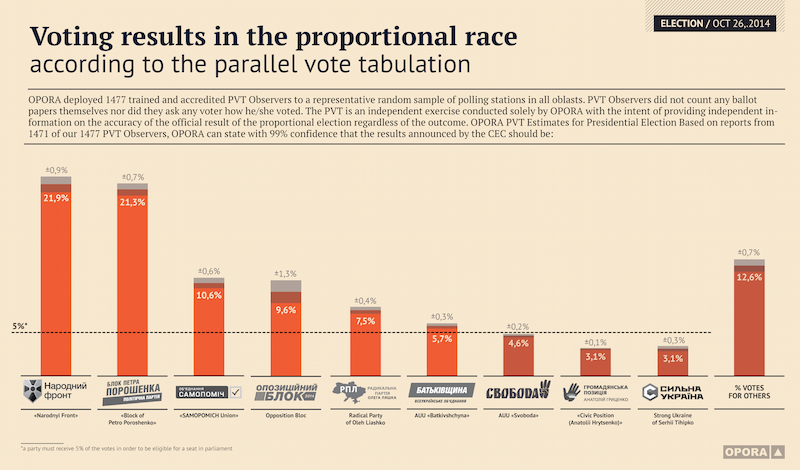OPORA conducted parallel vote tabulation based on a statistically random sample of polling stations where observers received representative election results on party lists (in a nationwide multi-mandate district). Particullary for this purpose, OPORA deployed 1477 trained and accredited observers who monitored the voting process, vote counting and received actual data from protocols of election commissions protocols, results of which they trusted. PVT is not a poll, but a method for results evaluation based on the real protocols filed at polling stations chosen according to a sociological sample.
Data is received from 1473 out of 1477 polling stations which were chosen (99,7%, 791384 votes). OPORA is 99% sure that once the Central Election Commission (CEC) announces the official results, they will be the following:

Frequently Asked Questions about PVT
What is a PVT?
A Parallel Vote Tabulation (PVT) is a proven methodology often employed by nonpartisan citizen observers to systematically assess the election day process including the counting of results at polling stations. If the election process has gone well, then the PVT can independently verify the official results announced by the Central Election Commission (CEC). A PVT relies on reports from highly trained observers who evaluate the quality of the process at the polling station. Unlike exit polls, PVTs do not ask people how they voted. Rather, the PVT counts the actual votes cast at polling stations where the entire process has been monitored. The PVT methodology has been successfully used by citizen organizations to evaluate the election day processes in many countries around the world, including Bulgaria, Romania, and Georgia.
Why is a PVT (Parallel Vote Tabulation) needed?
When a Parallel Vote Tabulation (PVT) is properly done by a citizen group, it reduces uncertainty from the election environment by providing evidence-based analysis of the election process based on first-hand observer reports. A PVT can confirm the official results and increase confidence in a well-run election. A PVT can also expose fraud, or identify problems in the process and assess the impact such problems may have on the outcome of the election. Thus, PVTs reduce the potential for political conflict.
What kind of information does the PVT provide?
PVTs produce statistically reliable and valid data on which to base an assessment of the election process. The PVT collects two types of information:
1. Information on the conduct of the process:
- PVT observers use a standardized form that allows them to evaluate the integrity of the opening, voting and counting processes.
- Example qualitative findings from OPORA’s PVT for the 2014 Extraordinary Presidential Election:
- Determining whether the vote counting process accurately captures the will of the people as expressed at the ballot box by witnessing the full election-day process and verifying that no significant irregularities occurred.
- This data are examined only after the information on the conduct has demonstrated that the voting and counting processes went well.
- The PVT can project the results of the proportional election and voter turnout with a high level of precision (i.e., low margins of error)
In 99% of the polling stations, the PEC members signed the protocol for the presidential results.
In only 1.1% of the polling stations did a PEC member registered a dissenting opinion on the protocol.
2. Official election results for the proportional race, as reflected in the PEC protocols:
- This data are examined only after the information on the conduct has demonstrated that the voting and counting processes went well.
- The PVT can project the results of the proportional election and voter turnout with a high level of precision (i.e., low margins of error)
How precise is the PVT?
During the presidential election last May, a total of 861,148 Ukrainians cast their ballots at the 1,500 sampled PVT polling stations monitored by the PVT. The margin of error for Yulia Tymoshenko was +/-0.6% and so, the range predicted by the PVT was 12.6% to 13.8%. The official number announced by the CEC, 12.8%, was within the range predicted by the PVT. There will likely be many exit polls attempting to project results. However, the highest sample size for exit polls conducted in the last election was 17,000 in 400 stations, so any exit poll is likely to be much less precise than the PVT.
What if fraud is committed at the level of the District Election Commissions (DECs)?
If precinct-level results are trustworthy, then the results announced by the CEC should fall within a range established through statistical analysis. If the official results do not match the range predicted by OPORA’s PVT, then it would be an indication that results have been changed or manipulated at the district or central level. By monitoring the full election day process at the polling station level, OPORA is present at the place where ballots are cast. That allows OPORA to assess whether the official results accurately reflect the will of the people.
What is OPORA’s experience with conducting PVT?
The Civil Network OPORA is a non-governmental, non-political and financially independent nationwide network of public activists that was formed in 2006. OPORA has used the PVT methodology during the 2010 presidential election, the 2010 presidential election runoff, and the 2012 parliamentary election, the 2013 re-run parliamentary elections and the Extraordinary Presidential Election earlier this year. On October 26, 2014, OPORA sent 1,600 observers to a nationally representative sample of polling stations where they will gather qualitative and results information for the PVT. For the 2014 parliamentary elections, OPORA deployed 198 long term observers across the country to monitor the pre-election process.